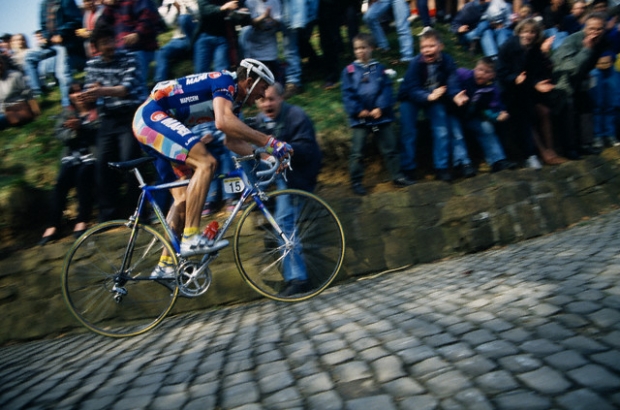- Daily & Weekly newsletters
- Buy & download The Bulletin
- Comment on our articles
Tour of Flanders: Belgium's biggest sporting event gears up for centenary edition
Tiesj Benoot, one of Belgium’s brightest cycling hopes, grew up on the Tour of Flanders, watching from the sidelines for a full 15 years before he got his first bite at it last year.
“It was a dream come true to finally do it, after all those years as a spectator,” he says. “It gave me goosebumps: the cheers from the crowd ring in your ears like the music from a nightclub. It’s so amazing – you don’t see it anywhere else. The crowds line up in every little village, and they go crazy.”
Ghent-born Benoot, 22, is now a key member of the Lotto-Soudal team. He turned professional last year, and in his first attempt at the Tour he came in fifth. “It was so exciting. I had a real sense of achievement, even though it didn’t properly sink in until much later,” he says.
It’s a refrain that has been heard for over a century as the Tour – or Ronde Van Vlaanderen – has coursed through the region. The world’s greatest cyclists test their mettle on the hills, mud and cobbles over the route that runs this year over 256km from Bruges to Oudenaarde. With up to 800,000 spectators, it’s the biggest sporting event in Belgium.
This year’s edition, on 3 April, is special, as it’s the 100th race. The first edition was in 1913, with the First World War breaking out just after the second edition the following year. The Tour resumed in 1919, and has been uninterrupted ever since, even during the Second World War.
Epic contest
To celebrate 100 tours, this year’s event will pay homage to the past winners: all those still living, including the legendary double-winner Eddy Merckx, will be honoured, with King Filip leading the tributes.
Why has the Tour become such an epic cycling event? Wim Van Herreweghe, the organiser, offers three reasons. “Firstly, there have always been a lot of professional cyclists in Belgium, and a lot of cycling stars,” he says. “Second, the cobbles and hills give it a unique package. And, thirdly, the people: it’s like their national day. There’s no other event, no football, nothing else matters.”
He says the biggest challenge for organisers is safety. “The riders are so near. You can touch them, you can even smell them. That’s good, but it can be scary,” he says.
The Ronde was conceived by Karel Van Wijnendaele of the sporting paper Sportwereld, and was first held on May 25, 1913. Some 37 riders took part in the 330km race that ran through Sint-Niklaas, Aalst, Oudenaarde, Kortrijk, Veurne, Ostend and Bruges and finished on a wooden track at Mariakerke, now a suburb of Ghent.
Only in the 1920s did it catch on and establish itself. Thanks to some fierce weather over the years, and the fearsome cobblestones, it’s now seen as a vital test for the world’s greatest cyclists and is arguably the highlight of the pro cycling season.
Brutal climbs
The route has changed many times over the years. All the races began in Ghent until 1976 when Sint-Niklaas took over, followed by Bruges in 1998. Until 1973, most of the finishes were in or around Ghent, before Meerbeke won the honour; then last year, Oudenaarde muscled in.
The route of the 100th edition turns south after leaving Bruges’ Markt, heading south to Torhout, the birthplace of the Tour’s founder. After a flat sequence to Roeselare and Zulte, it turns southeast to the climbs of Oude Kwaremont and Paterberg. The race finale takes in the ascent of the 22% gradient Koppenberg, the Steenbeekdries climb, Taaienberg, and Paterberg, before finishing on Oudenaarde’s Minderbroederstraat.
Flemish riders, who have struggled to make their mark in the Tour de France or the Olympics in recent years, are under particular pressure to prove their mettle on home soil. The last Belgian champion was three-time winner Tom Boonen, in 2012. This year, Switzeland’s three-time winner Fabian Cancellara is again the favourite, followed by Slovak Peter Sagan, last year’s winner Alexander Kristoff from Norway, Greg Van Avermaet from Lokeren, and Sep Vanmarcke from Kortrijk.
For Benoot, who came second in the five-day Tour of Belgium last year, the Tour of Flanders will be the highlight of his year – unless he qualifies for the road race at the Rio Olympics in the summer. But while some might curse the cobbles and hills, he craves it. He even adores the brutal winds and rain that can torment the riders.
Indeed, the Tour of Flanders has always been associated with terrible weather, and the driving rain, wind and hail have been responsible for helping define the race’s identity. “I like it in the rain,” he says. “That’s when I do my best performances. Hot weather makes me sweat a lot, but the rain is so refreshing.”
Photo: Frederic Haslin/TempSport/Corbis









